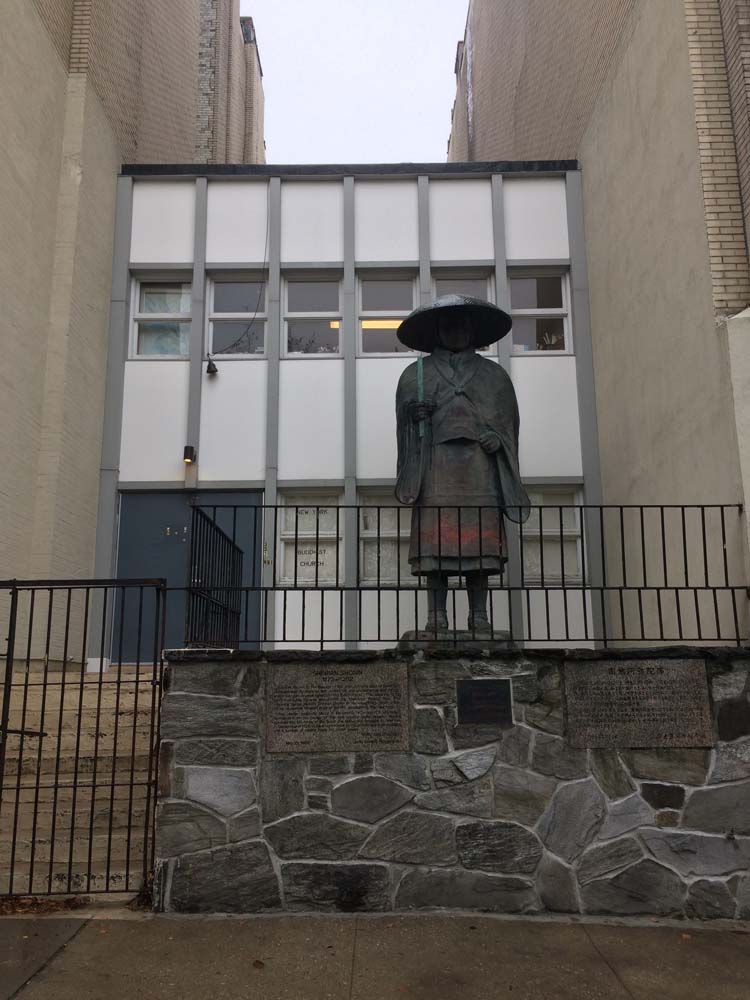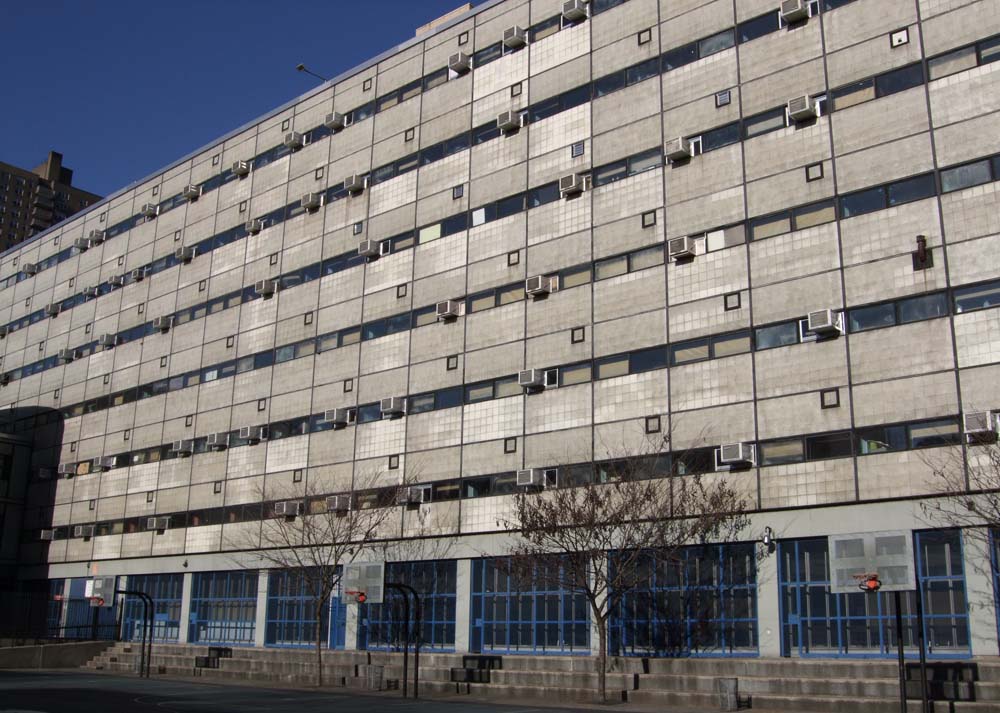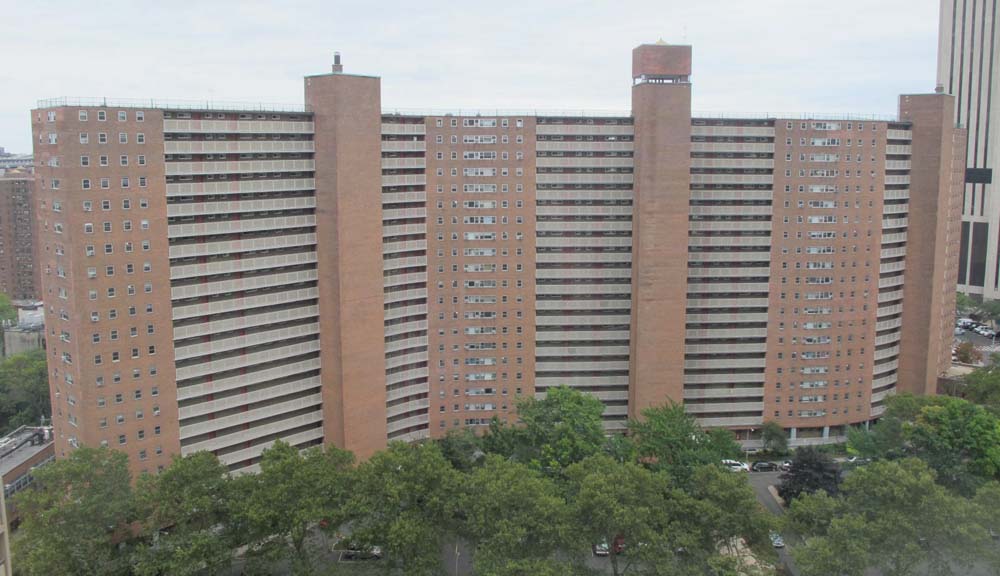Kelly & Gruzen was founded in 1936 through the partnership of engineer Hugh A. Kelly (February 8, 1888-January 31, 1966) and architect Barnett Sumner Gruzen (July 25, 1903- September 27, 1974). The firm began gaining major commissions from the military, as well as civilian projects in New Jersey, where they opened their first office. Kelly retired from the firm in 1950. Early work includes barracks in Fort Monmouth (1951) and housing developments in Hackensack (1950), Schenectady, NY (1950), and Newark (1951). They also completed several shopping centers through a relationship with Grand Union Supermarkets [1].
By 1955 the firm had received early acclaim for the unique design of George Wingate High School in Brooklyn (1955), a three story complex for 3,200 students in Flatbush with a unique banjo shape that was created to cut down on congestion within the halls and shorten time between classes. It was the first new high school completed in New York City in a decade. This was followed the next year by more educational buildings, this time for the Einstein College of Medicine in the Bronx.
While Kelly & Gruzen was eventually known for many types of architecture, both public and private, educational structures are a definite focus over the many decades the firm has been in operation. The School of Printing (1958) was notable for its use of glass block across the entire curtain wall facade to allow diffused light into all spaces. The complex also incorporated a striking entrance mural by Expressionist artist Hans Hoffmann. Other schools include Junior High School 22 (1961) on the Lower East Side, a two-story structure clad in blue and white tile, elevated above a central courtyard; and Murray Bergtraum High School (1971) located within the Municipal Center on Pearl Street. Later the firm also completed significant commissions at Queens College.
By the mid-60s, the firm had grown far beyond its origins, with offices in San Francisco, Newark, Washington DC, and New York City. Partially due to the death of founder Hugh Kelly the previous year and partially to recognize the influx of young new talent, the firm changed its name to Gruzen Partners in 1967 with six new partners, including Peter Samton, Richard Rosenthal, and Rolland Thompson of the existing firm, and Norval White, Julian Whittesley, and William Wilson, who had run their own firms [2].
Longtime firm partner Peter Samton was himself raised in Queens and takes pride on the amount of work the firm has done in the borough [3]. Postwar work includes three Queens Chamber of Commerce Building Award winners: Kneseth Israel in Far Rockaway, a synagogue with a round sanctuary; Williams Memorial Residence for the Aging in Flushing, a narrow pavilion now sandwiched between later additions; and Kissena II Apartments, a 19-story Mitchell-Lama housing complex of brick and concrete that represented an ongoing relationship between the firm and Selfhelp Community Services, an affordable housing developer.
Civic projects was another area where the firm excelled and these commissions changed the face of the city. In Lower Manhattan alone, Chatham Towers, Chatham Green, Murray Bergtraum High School, and One Police Plaza are prominent landmarks. Both Chatham Green and the slightly later Chatham Towers were prominent examples of middle class housing, the former a sinuous single structure with exterior hallways and the latter, two 25-story concrete slab towers within a M. Paul Friedberg-designed landscape. One Police Plaza, an elegant brick cube of offices elevated above common spaces, sits behind the towering Municipal Building and bookends a large public plaza. All these projects were covered favorably by critics upon their completion.
Unlike many of the firms with significant bodies of work in the mid-century, Gruzen & Partners continued to grow rapidly through the 1970s and until the end of the decade. Becoming Gruzen Samton in 1986, they left their mark across the region, nationally, and internationally. However a broader study of their significance falls outside of the scope of this project. But based on their work in the mid-20th century alone, their reputation is secure.
Sources
- Samton, Peter. Interview with author at Samton Residence. 12 May 2016.
- Firm press release. 10 May 1967. American Institute of Architects Archives. Online scan.
- Samton, Peter. Interview with author at Samton Residence. 12 May 2016.
Selected Projects
Yonkers Naval Reserve Training Center, Yonkers, 1947
515 7th Avenue, NYC, 1949
Oratam Court Housing Project, Hackensack NJ, 1950
Van Buren Park Homes, Schenectady NY, 1950
Ivy Hill Park, Newark NJ, 1951
Signal Corp Barracks, Fort Monmouth NJ, 1951
Power Memorial Academy Gymnasium, NYC, 1952
Grand Union Shopping Center, Saratoga Springs NY, 1952
Van Dyke Houses, Brooklyn, 1952
YMHA of Washington Heights, NYC, 1953
Cryders Point (with George Miller), Whitestone NY, 1954
Milton Steinberg House at Park Avenue Synagogue, NYC, 1954
George W. Wingate High School, Brooklyn NY, 1955
American Buddhist Academy, NYC, 1955
Albert Einstein College of Medicine Forchheimer Building, Gottesman Library, and Robbins Auditorium, Bronx NY, 1956
Sunset Green, Yonkers NY, 1956
Oak Park Shopping Center, Clifton Heights PA, 1956
Clinton Place Junior High School, Newark NJ, 1956
Roger High School, Newport RI, 1956, addition 1960
Beth Israel Hospital Laboratory, Newark NJ, 1957
NY School of Printing, NYC, 1958
Lincoln Guild, NYC, 1959
Luna Park Houses, Brooklyn NY, 1961
US Mission to the UN Building (with Kahn & Jacobs), NYC, 1961
Canton City Hall (with Cox & Forsythe), Canton OH, 1961
University Towers, Brooklyn NY, 1961
Junior High School 22 and Hamilton Fish Park Library, NYC, 1961
River View Towers, NYC, 1962
Litho City, NYC (unbuilt), 1963
Spanish Pavilion, 1964 World’s Fair (with Francisco Javier Carvajal Ferrer of Madrid), Corona NY, 1964
American Express Pavilion, 1964 World’s Fair, Corona NY, 1964
St Tropez, NYC, 1965
Horizon House Phases One-Four, Fort Lee NJ, 1965
Williams Memorial Residence for the Aging, Flushing NY, 1965
Science Humanities and Library for Rutgers University, Newark NJ, 1965
Kneseth Israel, Far Rockaway NY, 1965
100 Gold St, NYC, 1966
West Side Manor, NYC, 1966
Montefiore Hospital and Medical Center Loeb Pavilion (with Helge Westemann), Bronx NY, 1966
Police Precinct and Riding Stables (unbuilt), Central Park, NYC, 1967
Hebrew Home for the Aged Goldfine Pavilion, Bronx NY, 1967
Lindsay Park Houses, Brooklyn NY, 1967
Congregation B’nai Jeshurun (with Pietro Belluschi), Short Hills NJ, 1968
Earth and Space Sciences Building, SUNY Stony Brook NY, 1968
One Police Plaza, NYC, 1969-1975
Beekman Downtown Hospital Apartments, NYC, 1969
Solow Towers, NYC, 1969
Dormitory and Dining Hall, SUNY Stony Brook, Stony Brook NY, 1969
Montefiore Hospital and Medical Center (with Westermann/Miller Associates), Bronx NY, 1970
Kissena II Apartments, Flushing NY, 1970
Southbridge Towers, NYC, 1971
Murray Bergtraum High School, NYC, 1971





